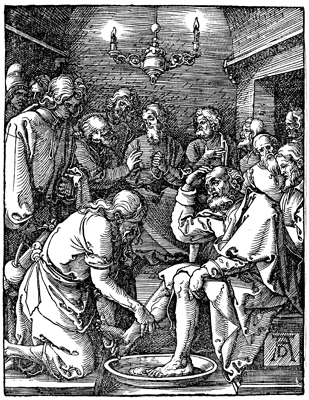Christ Washes Peter's Feet: A Theological Reflection

Albrecht Dürer, "Christ Washes Peter's Feet" (MSS 406)
When Peter asks Jesus why he washes his feet (John 13:6), Jesus answers "What I am doing you do not understand now, but you will come to know after these things." Jesus' words signal that this scene of the footwashing, unique to John's gospel, combines the two primary themes of the gospel, knowledge and love. Albrecht Dürer's woodcut "Christ Washes Peter's Feet," set just after this well-known dialogue, depicts not only the washing of Peter's feet in the foreground, but also the apostles' contemplation of the event in the background, inviting Jesus' followers likewise to consider how they will come to know.
Jesus' identification of "these things," after which true knowledge will come, of course, points proleptically to his own crucifixion, the gospel's demonstration of the love act of the good shepherd "laying down his life for his friends" (John 15:13; cf. John 10:11). True knowledge of the act of the master Jesus' servitude toward his disciples cannot come until his followers witness this final act of love.
In John, however, knowledge of love does not come simply by observing its enactment. Jesus tells the apostles that they cannot stop when they simply understand these things. Rather, "you are blessed if you do them" (John 13:17). Dürer's inclusion of the 12 apostles' contemplative responses, most prominently Peter's, a detail not present at the surface of John's narrative, invites observers to consider the significance of Jesus' act for their own lives. The prominence of these witnesses suggests a second meaning for "these things" that bring knowledge of what Jesus is doing, a meaning more closely connected to the actions of the witnesses. True knowledge of love comes not from observing others love, but from acting out love toward someone else. It is this knowledge through action that is the focus of the remainder of John's last supper scene, the inauguration of a "new commandment" from Jesus to love one another (John 15:9-17).
Jesus identifies in John 13:15 that his act of washing Peter's feet is an "example," a term that has a double meaning in John's narrative. Certainly Jesus' humble act is one particular example of his love for them, a love on full display in his dying for his friends at the cross. As Dürer's focus on the faces of the apostles suggests, though, Jesus' act is also "an example" of the way those around Jesus are to love one another. The gospel writer and Dürer both recognize that Christ's act of footwashing is as much about the audience as it is the Christ. Christ washing Peter's feet is a physical enactment of the narrator's transition statement to begin the last supper, the final scene of Jesus' ministry in John: "Having loved his own in the world, he loved them unto the end" (KJV). This final clause might better be translated "he loved them fully" (CEB), a translation that accurately captures the extreme nature of love depicted in scenes like the footwashing. John's gospel and Dürer's woodcut show not the final act of Jesus' love, but the extreme nature of that love, a love which he calls all who follow him to embody.
By Richard M. Adams, April 2017
Return to the Dürer, Small Passion Woodcut collection (MSS 406) page.
